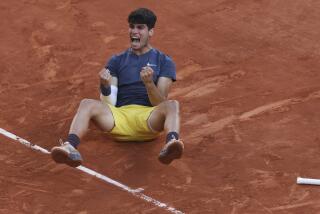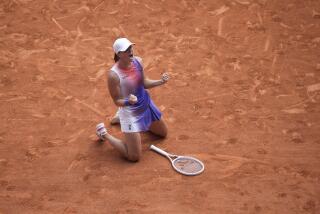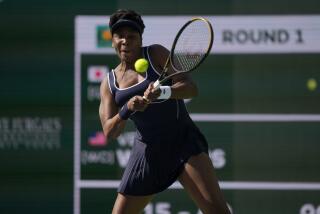Venus, and Beads, Are Hit in French Open Debut
- Share via
PARIS — Two and a half years after her decision to turn pro was met with as much consternation as anticipation, Venus Williams played her first match in a Grand Slam tournament Monday, the opening day of the French Open.
Everything about the 16-year-old Williams is unconventional. She never played junior tennis before turning pro and, having won the right to play professionally, she has scarcely played on the tour since then. This is only her fourth tournament of the year.
It is also curious that Williams would chose to begin her Grand Slam tournament career here at Roland Garros. The French Open is her first tournament ever outside the United States. As always, Williams does things on her own, distinctive terms. On a warm spring day, that style included an impressive defeat of Japan’s Naoko Sawamatsu, 6-2, 6-7 (7-2), 7-5.
Williams is ranked No. 90 and Sawamatsu No. 45, but the match was highly anticipated. The small but cozy Court 1 was three-quarters full, unusual for a match between unseeded players of such rank. More unusual still was the full-to-bursting officials’ box, as off-duty linesmen and chair umpires flocked to get their first look at much-discussed but seldom-seen Williams.
She’s fun to watch. Her movements on court are announced with the now-familiar click-click of the beads in her hair colliding. She adopted a style of standing between changeovers, intending to send a fitness message to her opponent.
By tennis’ bland standards, Williams counts as an exotic creature. Just to watch a teenager playing in her first Grand Slam tournament is an exciting prospect. When that young player is as unpredictable as Williams, the stakes go higher.
Richard Williams remained home in Florida while his wife, Oracene, is here with Venus and her younger sister, Serena.
Richard is normally an ever-present figure where Venus is concerned, but she said he stayed home “because he said he wasn’t going to start a second career as a parent in the stands. I don’t want him to do anything he doesn’t want to do. My mother’s here. Possibly he’ll come to the next one.”
Meaning Wimbledon, which offers a surface that well suits Williams’ game. On grass, her big serve and hard strokes would be amplified.
Here, Williams plays the clay in Pete Sampras fashion, electing to retain the same style she uses for hardcourts and hope for the best. Williams practices on clay at home, so she’s not unaccustomed to the surface and its special requirements, prime among them being patience.
Williams has a teenager’s temperament. Sawamatsu wisely created long rallies that caused Williams’ impatience to flare. When she wanted to end a point, she did it with power, nevermind what prudence might dictate. Too often, those hard-hit shots went astray: Williams committed 43 unforced errors.
“Today, I played a lot better than I thought I would,” Williams said. “I thought I was going to be erratic. Sometimes I can be that way, especially if I start rushing. It’s kind of the way you play in a hard court, not clay court.”
For all of her remarkable athletic ability, Williams is often out of position and hitting off her back foot. But her strength is so great that even a mis-hit ball off the frame of her racket is sent across the net with tremendous pace.
Her sometimes-impetuous style was in marked contrast to the steady, flat-hitting Sawamatsu. Williams looked at ease and in control in the first set and won the second-set tiebreaker with little trouble.
She was not at all flustered in her debut. Even the constant chattering of squirrels in an adjacent stand of trees did not distract Williams.
“Mentally, I think she was great,” Sawamatsu said. “I was up 3-1 in the third and I thought she would start to lose her concentration, but she didn’t.”
Williams did commit one of tennis’ cardinal errors. She stopped playing in order to dispute a line call. Sawamatsu was serving in the ninth game, facing a break point. In the middle of the point, Williams called a Sawamatsu shot “long,” pointed at the mark and then stopped playing. No call was made from the linesman and Sawamatsu continued to play.
Williams ignored the shot and walked to her chair. Sawamatsu stood at the net, incredulous, as the chair umpire checked the mark on the court. He reversed the earlier no-call and gave Williams the point, the break and a 5-4 lead.
Sawamatsu called for a trainer during the changeover and while her foot blister was being attended to, Williams was treated to mini-lecture from a tour official regarding continuous play.
Her first lesson in international relations.
More to Read
Go beyond the scoreboard
Get the latest on L.A.'s teams in the daily Sports Report newsletter.
You may occasionally receive promotional content from the Los Angeles Times.











